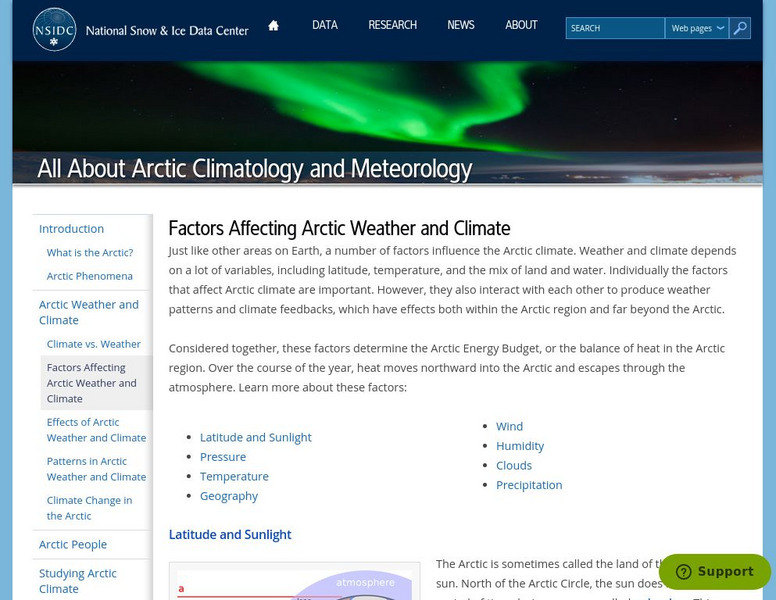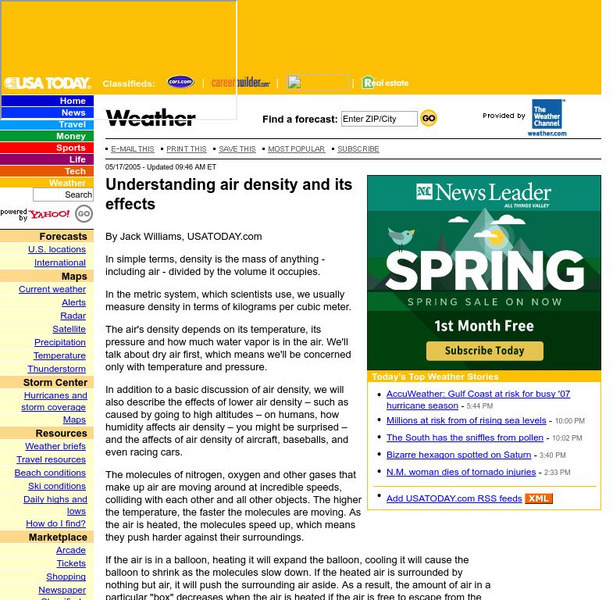TeachEngineering
Teach Engineering: Air Pollution
Students are introduced to the concept of air quality by investigating the composition, properties, atmospheric layers and everyday importance of air. They explore the sources and effects of visible and invisible air pollution. By...
CK-12 Foundation
Ck 12: Earth Science: Atmosphere: Pressure, Density, and Temperature Study Guide
[Free Registration/Login may be required to access all resource tools.] Summarizes the key points about atmospheric processes involving air pressure, air density, and temperature. Includes a few questions to check for understanding.
Scholastic
Scholastic: Dirtmeister's Science Lab: The Air Is There
An experiment to see how the temperature of an object affects how high it bounces. This site contains web links and notes for the teacher.
University Corporation for Atmospheric Research
Ucar: Clouds in the Air: Why Are They There?
An experiment that demonstrates why there are clouds in the sky. Start with air, invisible water vapor, particles we call condensation nuclei, and air pressure...the cloud comes later!
University Corporation for Atmospheric Research
Ucar: How Weather Affects Air Quality
How is air pollution affected by weather? Some types of pollution are worse in the summer heat, while others are worse in cold winter weather.
CPALMS
Florida State University Cpalms: Florida Students: How's the Weather?
A tutorial that describes the five factors that determine the weather in a particular place and time. The factors discussed in this tutorial are air temperature, air pressure, humidity, wind, and precipitation. A PDF file of the tutorial...
Texas Instruments
Texas Instruments: Temperature vs. Atmospheric Pressure: Is There a Correlation?
Relating Temperature to Atmospheric Pressure by using the CBL 2 unit and the temperature probe in relation to the gas pressure probe.
Science Education Resource Center at Carleton College
Serc: Observing the Effect of Temperature on Change of State and Gas Pressure
This lab serves as a short introduction to both changes in state and air pressure/the gas laws. The students will heat a small amount of water in an aluminum can. They will then invert it in a bucket of cold water and crush the can using...
Science Education Resource Center at Carleton College
Serc: Exploring Atmospheric Pressure by Making a Barometer
Students create their own barometer, calibrate it with the actual air pressure data, and compare that data with the boiling temperature of their water. They learn from this that atmospheric pressure affects the boiling points of liquid....
University of Illinois
University of Illinois Urbana Champaign: Observed Dew Point Temperature
Describes what dew point is and how it relates to moisture content of the air. Also explains condensation and relative humidity.
Other
Baranidesign: Air Density Calculator
A calculator that computes air density if altitude, temperature, humidity, and barometric pressure are known.
NASA
Nasa: Gas Properties Definitions
Use this site to learn about basic gas properties including motion, viscosity, and compressibility. Includes links to activities for all ages.
National Snow and Ice Data Center
National Snow and Ice Data Center: Factors Affecting Arctic Weather and Climate
An introduction to the factors that affect the Arctic's weather and climate: latitude, land/sea distribution, solar radiation, air temperature, air pressure, winds, humidity, clouds, and precipitation.
USA Today
Usa Today: Understanding Air Density and Its Effects
In simple terms, density is the mass of anything - including air - divided by the volume it occupies. In the metric system, which scientists use, we usually measure density in terms of kilograms per cubic meter. The air's density depends...
Colorado State University
Csu: Four Stroke Fuel Air Otto Cycle Gasoline (C7 H17)
A Java applet which allows the visitor to investigate the physical parameters associated with the individual strokes of a 4-stroke gasoline engine. Visitors enter parameters such as exhaust temperature, fuel ratio, and ambient pressure...
Science Education Resource Center at Carleton College
Serc: Mn Step: Temperature Volume Relationship of a Gas
A lab activity where students investigate the relationship between temperature and volume using a plastic syringe with a stopper. The syringe, filled with trapped air, is placed in a hot and a cold water bath, and temperature and volume...
TeachEngineering
Teach Engineering: Weather Watchers
Learners are introduced to some essential meteorology concepts so they more fully understand the impact of meteorological activity on air pollution control and prevention. First, they develop an understanding of the magnitude and...
American Geosciences Institute
American Geosciences Institute: Wind Classroom Activities
When air is warmed, it expands and becomes less dense. As the air becomes less dense, its air pressure decreases. This occurs because molecules in warm air have greater kinetic energy (energy of motion) than in cold air. As the molecules...
Alabama Learning Exchange
Alex: I'm So Crushed
In this activity, learners will have an opportunity to solve a mystery. They will discover why a soda can collapses during a demonstration due to the effects of changes in temperature and atmospheric pressure. Students will gain further...
Concord Consortium
Concord Consortium: Molecular Workbench: Barometric Formula
Adjust the altitude and temperature in this simulation to observe how gas pressure is affected by these changes.
American Geosciences Institute
American Geosciences Institute: Earth Science Week: Build Your Own Weather Station
Students are guided in how to build their own weather station that will measure temperature, humidity, precipitation, atmospheric pressure, and wind direction and speed.
NASA
Nasa: Beginner's Guide to Aerodynamics
Includes exhaustive information and a wealth of activities pertaining to aerodynamics and the physics of flight.
OpenStax
Open Stax: Requirements for Human Life
Earth and its atmosphere have provided us with air to breathe, water to drink, and food to eat, but these are not the only requirements for survival. Although you may rarely think about it, you also cannot live outside of a certain range...
University Corporation for Atmospheric Research
Ucar: Virtual Ballooning to Explore the Atmosphere Activity
In this computer-based virtual lab, students will learn about the layers of Earth's atmosphere by launching virtual balloons to collect temperature and pressure data at various altitudes. Given a limited number of balloon flights,...






















